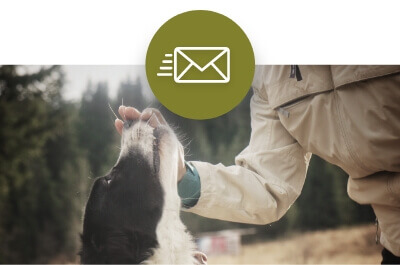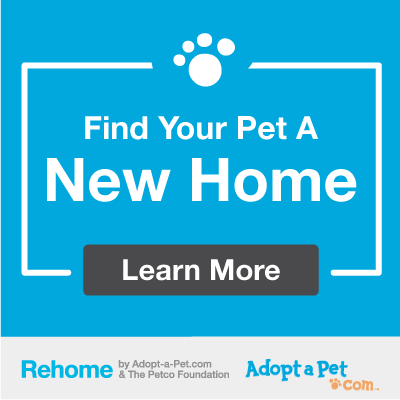Does your newly adopted pet follow you everywhere? Learning how to treat separation anxiety in dogs is critical to a relaxed and happy home life – for both you and your new pet.
Follow these tips from our Board member, expert dog behaviorist and trainer Andrea Arden. Andrea appears regularly on pet-related segments for the Today Show, and is featured frequently on Animal Planet, Discovery Channel and other media outlets.
Parting is such sweet sorrow
Active and retired service members know all too well how stressful their departures and absences can be on their families. As members of our families, dogs can also suffer from stress caused by being left behind. For some dogs, this includes being ‘left behind’ as family members move from one room of the home to another.
Me and my shadow
A rescue dog coming into a new home may have a sense of unease, which will make them more likely to ‘shadow’ someone around the home as they are looking for support and companionship.
Keep in mind that if your dog spent time in a shelter, they were presumably surrounded by staff, volunteers and other animals during the day, and other animals at night. So many recently adopted dogs are not used to being alone and this may add to their inclination to shadow one or more family members.
It can be heartwarming and rewarding to have a newly adopted animal bond with us and seek out our companionship, even if that means they attempt to do so on a constant basis. However, there is a downside to this ‘shadowing’ or ‘Velcro’ type behavior, as it is characteristic of a dog that may potentially suffer from stress and separation anxiety when not able to be by your side.
Further, a new pet latching on to one family member could be alienating for other family members.
It’s important to bear in mind that all family members should participate in social bonding with the animal, especially if the animal’s chosen favorite is the person who may be leaving for military service. It really is about helping your new pet to develop the ability to self-pacify when left alone and to find a balance of affection amongst all family members so the dog doesn’t fall apart when anyone or everyone leaves.
Helping your newly adopted dog learn to develop self-pacifying skills should be a top priority, as doing so from the start is easier than allowing an unwanted behavior pattern to develop and then trying to resolve it.
Bonding with your pet: how much is too much?
When adopting a new dog we may feel compelled to spend lots of bonding time with them at the start. This can certainly be beneficial. However, it can also have its drawbacks.
Be careful not to spend so much time with your new dog in the first weeks he or she is home that you set a precedent you can’t support throughout your dog’s life. You want to help your dog learn how to cope with typical family life from the very start, and part of that will surely include the dog being expected to spend time alone and not shadow you about the house.
A dog’s ability to have success with being able to self-pacify when left alone is based in part on a genetic predisposition. But the dog’s early education also plays a key role.
Some dogs have the benefit of having early, gradual and appropriate time alone experience. Others were never provided adequate guidance in this regard. With that said, be patient with your dog and his or her unique propensities. Taking a calm, gentle and gradual approach to this or any other training protocol is the best route to success.
Tools, tips and tricks for proper bonding
When bringing home a newly adopted dog, it is best to err on the side of caution and assume your dog will need to start with very low exposure to alone time and gradually build towards a more practical period of time left alone – such as you leaving to go grocery shopping, to school, or to work.

This can start with having your dog on a 6-foot leash, which can be used to secure your dog to a stable object in the same room you are in. Provide your dog with a comfortable spot to rest and a chew toy which will provide them with entertainment.
Some of the best options are those toys which can be stuffed with the dog’s normal meals or special, nutritious treats. Examples are white sterilized bones, Monster Mouths, Busy Buddy Twist n’ Treats and Kongs. This way your dog can keep busy doing something appropriate – and fun – and stay in one spot as you move about the room.
At first, your dog may show signs of concern with being restrained away from you, even if just a short distance. But with practice, he or she should be less inclined to be concerned. At this point, you can start to move your dog to different tether spots around the room and then practice leaving the room for short bits of time.
Practice in as many areas of the home as possible will help your dog learn to be calm, cool and collected in many spots regardless of where you are in the home.
In addition to tethering, you can use baby gates to create a separate area for your dog so they get used to you coming and going in the house, and don’t have to be at your heels all the time.
This sort of brief separation and prevention of shadowing is especially important when you go out to put the garbage out or to check the mail. Doing all these things helps teach your dog to relax and wait for you to return.
You should also consider using feeding times as opportunities to help your dog practice alone time. Feeding them out of toys such as those mentioned above allows them to engage in an activity that doesn’t involve you, in a separate room, crate or other confinement area.
When separation anxiety in dogs is not all in the family
If this shadowing problem happens to be bonding to and following a particular family member, you might consider having other adult family members take primary charge of feedings, walks and training for a time. This way you may help your dog develop a more balanced sense of attachment.
Each family has their personal preferences in regards to whether or not their dog is permitted to sleep in bed with them.
As it relates to shadowing behaviors, having a newly adopted dog sleep in bed with you might be best put off until you have helped your dog develop the ability to spend time alone. This might mean a dog bed next to yours, or a crate in your bedroom.
If a family member is home all day and the dog has a lot of social time with them, this should be given special consideration.
The irony of man’s best friend
Dogs are supremely social animals and bond to people in a remarkably intense and rewarding ways. This is part of what makes them such wonderful family members. But this is also what makes it so difficult for all dogs – to varying degrees – to be alone.
The degree to which structure needs to be implemented varies according to the individual animal’s needs.
People tend to feel very guilty leaving their newly adopted dog alone, whether they are home or out.
But remember that you are setting the groundwork for the rest of your dog’s life where family patterns and routines change, and he or she will surely be expected to tolerate being left alone for some period of time. It is best to help them become accustomed to this from the start and balance this with lots of fun family time.
See more of my tips for dealing with separation anxiety in dogs.
– Andrea Arden












I found this article extremely validating. I have a rescue pet who was very much a Velcro pet.I found through behavior training, and a little medication he is now the pet I had hoped for. I do wonder however how he would fare with another pet introduce to my environment
Thanks for valuable information
and sharing with us keep it up
You’re welcome! Always happy to share information that helps pets and their parents have happy, balanced lives.